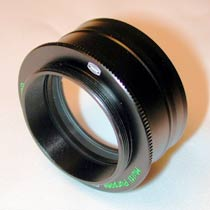 |
|
|
Carl Zeiss Abbe Eyepieces continue to be regarded as the finest astronomical eyepieces ever made. Around 1995, Carl Zeiss produced a very limited number of a newly designed matching 1.25" 2X Abbe-Barlow*. This doublet barlow incorporated a special high-quality ED glass, along with Zeiss' famous multicoatings, optical accuracy, smoothness, and surface quality. Discriminating planetary observers have found this to be the finest barlow ever produced. Unfortunately, due to their scarcity and unsurpassed performance, these barlows rarely surface on the secondary market, commanding extremely high prices - up to $1200 apiece! Baader
Planetarium
and Eridanus Optics CC are elated to
now offer
again the legendary Carl Zeiss Abbe-Barlow, in a new
redesigned housing. Carl Zeiss has produced a
new run of
these barlows, specifically for Baader
Planetarium. The
lenses have been mounted in an all-new housing, which
incorporates Baader's own Users of all 1 Baader has found
that the Zeiss
Abbe-Barlow works extremely well at magnifications up to
4X. Barlow users are no longer constrained to the
typical 2X/3X single magnifications provided by standard
barlows. The new housing enables users to vary the
magnification of the Abbe-Barlow simply by using
Barlow with 40mm Extension Tube, 2.6x Magnification Owners of Zeiss Abbe eyepieces now have an opportunity to finally complete their set, as Zeiss had intended. With the 2X Abbe Barlow, their available set of focal lengths doubles and fills-in the gaps between focal lengths (2,3,4,5,6,8,10,12.5,16,17,25,34). International customer feedback: Oh, and the Baader Zeiss barlow is astonishing! I've used what I consider to be high quality barlows in the past but none were as invisible in the optical chain as the Baader/Zeiss. Don Bledsoe | |
 |
|
The Baader
Planetarium
VIP Modular Barlow is a complete high quality 2X photo-visual
barlow system. Designed to accept |
♦
|
MPCC Coupled to 2" eyepiece |
MPCC(ready to attach to any DSLR or CCD Camera) |

MPCC Configured for 1.25" Eyepieces | |
|
The Baader Planetarium MPCC enables owners of fast Newtonian telescopes to use their instrument for taking stunning wide-field images, or visually, for delivering wide-field views with stars that remain pinpoint to the edge - with no magnification increase!. The MPCC has been
optimized for
Newtonians with focal ratios from f/4 to f/6, and will deliver
12micron stars across a full 35mm frame size.
Independent optical laboratory tests (by ITE) have confirmed
that the MPCC is the sharpest wide-field coma corrector
available, and provides the best edge of field
illumination. Visual users have reported great results
even down to f/3.7. The optics are anti-reflection
coated with the finest 7 layer multi-coatings
available.
The MPCC is also priced very reasonably. It's modularity
lets you purchase only the parts you need. For imaging
with DSLRs, only the MPCC is required. For
visual, the
MPCC can be configured with any of our eyepiece
holders or
directly coupled to 2" eyepieces using VISUAL
IMAGING The MPCC is the ideal match for today's Digital SLRs. Owners of these new cameras find them to be ideally mated with today's fast f/4-f/5 Newtonians required to keep exposures short. The MPCC enables these users to fully correct their scopes and produce superb pinpoint color deep sky images without the complexity of more expensive CCD astrocameras. Owners of Vixen Newtonians will appreciate the inclusion of filter threads, and the high sharpness of the images. Unlike other coma-correctors, the MPCC does NOT extend the focal ratio (so, your images will be shot at the full speed of your telescope). The MPCC inserts
into 2"
focusers and has external T-threads on the output side
(and
is also threaded for standard 2"/48mm
filters).
Simply attach any 35mm film or digital SLR to the
MPCC, using
commonly available T-adapters. Users of CCD
cameras can
attach in the same way through the use of our "Using the Baader Multi-purpose Coma
Corrector from Alpine Astro the coma in my 12-inch f/5
telescope is gone - wow! - my images are now flat
across the
entire field, and I find that amazing, since this telescope
previously produced a moderate to large amount of coma
in my
images. The other delightful thing I found was
the MPCC
screws straight into the bottom of my 2-inch
eyepieces.
Thanks Baader, Thanks Alpine Astro." Paul
Mayo, SKY:Lab Astronomy Software The weight of the MPCC by itself is 80gm
(2.8oz). | |

|  |
|
A common limitation
that plagues
owners of most popular Schmidt-Cassegrain telescopes
is the
narrow field size and high magnifications produced by their
slow optical system (typically, f/10). Until
now, owners
of SCTs have lacked a truly versatile and high-quality method
of reducing their f/10 (or slower) systems for faster, wider,
photographic/CCD and visual fields. (note: the
telecompressor is not intended for use with the Meade native
f/6.3 SCTs). Baader
Planetarium has developed a truly unique and
extremely
versatile telecompressor system that delivers the
finest wide
flat fields your SCT is capable of. The key to
the Alan
Gee Mark II Telecompressor is its innovative optical and
mechanical design. Unlike the commonly available and
simple single-purpose solutions, the Alan Gee Telecompressor
Mark II has been engineered specifically to work well with
SCTs in a wide variety of visual and imaging
configurations. The unique design of the
Alan Gee
Telecompressor positions the lens elements several
inches
inside the telescope's central baffle tube (see the
That's right. The Alan Gee Mark II is designed to function with many popular binocular viewers. At last, you can use your large aperture SCT to produce stunning wide field binocular views. For more information on this unique telecompressor system, including some sample CCD images, please click on the link below. | |



